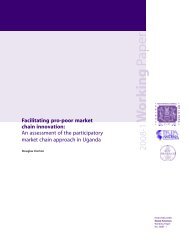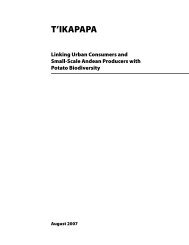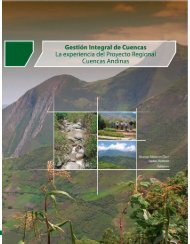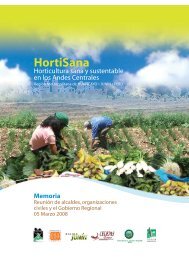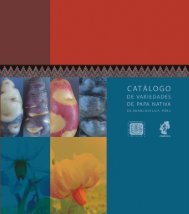Impacts of Urban Agriculture Annual Report.p65 - International ...
Impacts of Urban Agriculture Annual Report.p65 - International ...
Impacts of Urban Agriculture Annual Report.p65 - International ...
- No tags were found...
You also want an ePaper? Increase the reach of your titles
YUMPU automatically turns print PDFs into web optimized ePapers that Google loves.
Getting agriculture on themunicipal agenda in Lima34In 2003, as part <strong>of</strong> its research themes on urbanlivelihoods and markets and stakeholder andpolicy dialogue, <strong>Urban</strong> Harvest conducted diagnosticresearch on the contribution <strong>of</strong> agriculture tohousehold livelihoods in the district and on the other,sought to generate better understanding amongdecision-makers about the significance <strong>of</strong> local foodproduction with the aim eventually <strong>of</strong> incorporatingthe phenomenon <strong>of</strong> urban agriculture into localgovernment organization and planning.<strong>Agriculture</strong> is widespread in Lurigancho-Chosica, one<strong>of</strong> the largest and less urbanised city districts on theeastern fringe <strong>of</strong> Lima. Despite the significant contributionthat urban and peri-urban agriculture can make togenerating income and food security, this was untilrecently a little known or understood sector <strong>of</strong> the districteconomy despite the numbers <strong>of</strong> local people involved.Farming was absent from municipal organization orplanning and the voices <strong>of</strong> local producers were unheard.Lurigancho-Chosica is home to around thirty thousandfamilies with around 20% involved full-time or part-timein agriculture. Crop production is mainly located on theirrigated valley floor, which makes up nearly 45% <strong>of</strong> thedistrict area. Producers there grow and supply about 25%<strong>of</strong> metropolitan Lima’s vegetables, and also raise birds,guinea pigs, rabbits, pigs, cattle and goats. Almost 30% <strong>of</strong>landless families living on the poor hillside settlementsin the heart <strong>of</strong> the district also keep small animals foroccasional sales or home consumption. With almost athird <strong>of</strong> children under 6 affected by chronic malnutritionin Peru, this additional source <strong>of</strong> food and income is <strong>of</strong>tenvital for these families.Working with local producers and municipalmanagers and decision-makers, <strong>Urban</strong> Harvestfacilitated workshops, co-ordinated informationsharingand organised public events, such as fairs andvisits to model farms where ecological urbanagriculture is practiced. The first <strong>of</strong> three internationalworkshop meetings was held in October 2003. Invitedrepresentatives, including those from Havana (Cuba)and Cuenca (Ecuador), made presentations to localadministrators about how the incorporation <strong>of</strong> urbanagriculture within policy-making in their countries hadencouraged the development <strong>of</strong> greater food security,income and a greener urban environment for localpeople living there.The result <strong>of</strong> this first international workshop was thatdecision-makers were given solid evidence for thepotential <strong>of</strong> urban agriculture to enhance thelivelihoods <strong>of</strong> local people. As a consequence, themayors <strong>of</strong> metropolitan Lima publicly declared theirsupport for the development <strong>of</strong> urban agriculture. Thisled to a decision by the local district administration in2004 to create an <strong>Urban</strong> <strong>Agriculture</strong> Unit (Sub-Gerencia de Agricultura <strong>Urban</strong>a) within theDepartment <strong>of</strong> Economic Development.A second international workshop was held inDecember 2004. Representatives from the cities <strong>of</strong>Rosario (Argentina) and Azcapotzalco (Mexico), were






